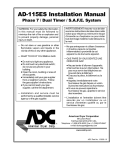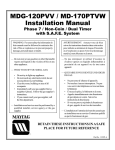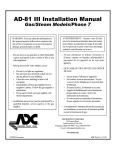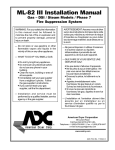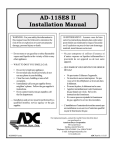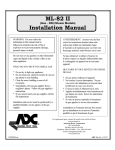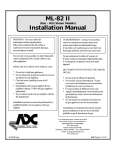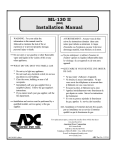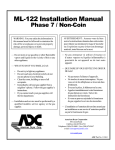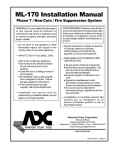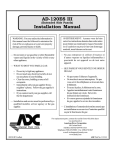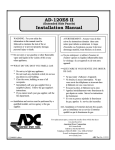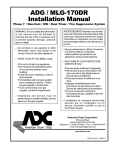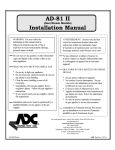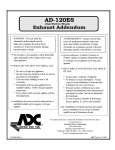Download American Dryer Corp. Extended Side Panel AD-120ES II Installation manual
Transcript
AD-120ES Installation Manual Extended Side Panels – Phase 7 WARNING: For your safety the information in this manual must be followed to minimize the risk of fire or explosion and to prevent property damage, personal injury or death. — Do not store or use gasoline or other flammable vapors and liquids in the vicinity of this or any other appliance. — WHAT TO DO IF YOU SMELL GAS: Do not try to light any appliance. Do not touch any electrical switch; do not use any phone in your building. ● Clear the room, building or area of all occupants. ● Immediately call your gas supplier from a neighbor’s phone. Follow the gas supplier’s instructions. ● If you cannot reach your gas supplier, call the fire department. ● ● — Installation and service must be performed by a qualified installer, service agency or the gas supplier. AVERTISSEMENT: Assurez-vous de bien suivre les instructions données dans cette notice pour réduire au minimum le risque d’incendie ou d’explosion ou pour éviter tout dommage matériel, toute blessure ou la mort. —Ne pas entreposer ni utiliser d’essence ni d’autres vapeurs ou liquides inflammables à proximité de cet appareil ou de tout autre appareil. —QUE FAIRE SI VOUS SENTEZ UNE ODEUR DE GAZ: Ne pas tenter d’allumer d’appareils. Ne touchez à aucun interrupteur. Ne pas vous servir des téléphones se trouvant dans le bâtiment. ● Évacuez la pièce, le bâtiment ou la zone. ● Appelez immédiatement votre fournisseur de gaz depuis un voisin. Suivez les instructions du fournisseur. ● Si vous ne pouvez rejoindre le fournisseur de gaz, appelez le service des incendies. ● ● —L’installation et l’entretien doivent être assurés par un installateur ou un service d’entretien qualifié ou par le fournisseur de gaz. American Dryer Corporation 88 Currant Road Fall River MA 02720-4781 USA Telephone: +1 (508) 678-9000 / Fax: +1 (508) 678-9447 e-mail: [email protected] www.amdry.com ADC Part No. 113386- 14 Retain This Manual in a Safe Place for Future Reference This product embodies advanced concepts in engineering, design, and safety. If this product is properly maintained, it will provide many years of safe, efficient, and trouble free operation. Only qualified technicians should service this equipment. OBSERVE ALL SAFETY PRECAUTIONS displayed on the equipment or specified in the installation manual included with the dryer. The following “FOR YOUR SAFETY” caution must be posted near the dryer in a prominent location. FOR YOUR SAFETY POUR VOTRE SÉCURITÉ Do not store or use gasoline or other flammable vapors and liquids in the vicinity of this or any other appliance. Ne pas entreposer ni utiliser d’essence ni d’autres vapeurs ou liquides inflammables à proximité de cet appareil ou de tout autre appareil. We have tried to make this manual as complete as possible and hope you will find it useful. The manufacturer reserves the right to make changes from time to time, without notice or obligation, in prices, specifications, colors, and material, and to change or discontinue models. The illustrations included in this manual may not depict your particular dryer exactly. IMPORTANT For your convenience, log the following information: AD-120ES DATE OF PURCHASE ______________________________________________ MODEL NO. ________________________ RESELLER’S NAME __________________________________________________________________________________ Serial Number(s) ____________________________________________________________________________________ ___________________________________________________________________________________________________ ___________________________________________________________________________________________________ Replacement parts can be obtained from your reseller or the ADC factory. When ordering replacement parts from the factory, you can FAX your order to ADC at +1 (508) 678-9447 or telephone your order directly to the ADC Parts Department at +1 (508) 678-9000. Please specify the dryer model number and serial number in addition to the description and part number, so that your order is processed accurately and promptly. “IMPORTANT NOTE TO PURCHASER” Information must be obtained from your local gas supplier on the instructions to be followed if the user smells gas. These instructions must be posted in a prominent location near the dryer. ! WARNING ▲ Proposition 65 Use of this product could expose you to substances from fuel combustion that contain chemicals known to the State of California to cause cancer, birth defects and other reproductive harm. IMPORTANT YOU MUST DISCONNECT AND LOCKOUT THE ELECTRIC SUPPLY AND THE GAS SUPPLY OR THE STEAM SUPPLY BEFORE ANY COVERS OR GUARDS ARE REMOVED FROM THE MACHINE TO ALLOW ACCESS FOR CLEANING, ADJUSTING, INSTALLATION, OR TESTING OF ANY EQUIPMENT PER OSHA STANDARDS. PLEASE OBSERVE ALL SAFETY PRECAUTIONS DISPLAYED ON THE EQUIPMENT AND/OR SPECIFIED IN THE INSTALLATION MANUAL INCLUDED WITH THE DRYER. BEFORE INSTALLATION, CHECK THAT THE LOCAL DISTRIBUTION CONDITIONS, NATURE OF GAS AND PRESSURE, AND ADJUSTMENT OF THE APPLIANCES ARE COMPATIBLE. “Caution: Label all wires prior to disconnection when servicing controls. Wiring errors can cause improper operation.” «Attention: Au moment de l’entretien des commandes, étiquetez tous les fils avant de les débrancher. Des erreurs de câblage peuvent entraîner un fonctionnement inadéquat et dangereux.» CAUTION DRYERS SHOULD NEVER BE LEFT UNATTENDED WHILE IN OPERATION. WARNING CHILDREN SHOULD NOT BE ALLOWED TO PLAY ON OR NEAR THE DRYER(S). CHILDREN SHOULD BE SUPERVISED IF NEAR DRYERS IN OPERATION. FOR YOUR SAFETY DO NOT DRY MOP HEADS IN THE DRYER. DO NOT USE DRYER IN THE PRESENCE OF DRY CLEANING FUMES. WARNING UNDER NO CIRCUMSTANCES should the dryer door switch(es), lint door/drawer switch(es), or heat safety circuit(s) ever be disabled. WARNING The dryer must never be operated with any of the back guards, outer tops, or service panels removed. PERSONAL INJURY OR FIRE COULD RESULT. WARNING DRYER MUST NEVER BE OPERATED WITHOUT THE LINT FILTER/SCREEN IN PLACE, EVEN IF AN EXTERNAL LINT COLLECTION SYSTEM IS USED. Dryer must not be installed or stored in an area where it will be exposed to water or weather. The wiring diagram for the dryer is located in the front electrical control box area. IMPORTANT Dryer must be installed in a location/environment, which the ambient temperature remains between 40° F (4.44° C) and 130° F (54.44° C). When discarding or storing your old clothes dryer, remove the door. Lorsque vous entreposez ou mettez votre sécheuse au rebut, enlevez-en la porte. WARNING DO NOT operate this appliance before reading the instruction booklet. WARNING DO NOT place articles on or against this appliance. Table of Contents SECTION I: SAFETY PRECAUTIONS .................................................................................................. 2 SECTION II: SPECIFICATIONS/COMPONENT IDENTIFICATION .................................................... 5 A. Specifications ..................................................................................................................................... 5 B. Component Identification .................................................................................................................... 7 SECTION III: INSTALLATION PROCEDURES ..................................................................................... 9 A. Location Requirements ...................................................................................................................... 9 B. Unpacking/Setting Up ....................................................................................................................... 10 C. Dryer Enclosure Requirements ....................................................................................................... 12 D. Fresh Air Supply Requirements ....................................................................................................... 13 E. Exhaust Requirements .................................................................................................................... 14 F. Electrical Information ........................................................................................................................ 19 G. Gas Information ................................................................................................................................ 22 H. Steam Information ............................................................................................................................ 25 I. Water Information ............................................................................................................................. 28 J. Preparation for Operation ................................................................................................................. 30 K. Preoperational Tests ........................................................................................................................ 31 L. Preoperational Instructions .............................................................................................................. 33 M. Compressed Air Requirements ........................................................................................................ 34 N. Shutdown Instructions ...................................................................................................................... 35 SECTION IV: SERVICE/PARTS INFORMATION ................................................................................ 36 A. Service ............................................................................................................................................. 36 B. Parts ................................................................................................................................................. 36 SECTION V: WARRANTY INFORMATION .......................................................................................... A. Returning Warranty Cards ............................................................................................................... B. Warranty ........................................................................................................................................... C. Returning Warranty Parts ................................................................................................................ 37 37 37 37 SECTION VI: ROUTINE MAINTENANCE ........................................................................................... A. Cleaning ........................................................................................................................................... B. Adjustments ..................................................................................................................................... C. Lubrication ........................................................................................................................................ 39 39 40 41 SECTION VII: DATA LABEL INFORMATION ...................................................................................... 42 SECTION VIII: PROCEDURE FOR FUNCTIONAL CHECK OF REPLACEMENT COMPONENTS 43 SECTION IX: MANUAL RESET BURNER HI-LIMIT INSTRUCTIONS ............................................. 45 LIST OF ACRONYMS D.M.S. DSI HVAC in WC L.E.D. L.P. OSHA R.M.A. UL Drill Measurement Size Direct Spark Ignition Heating, Ventilating, and Air-Conditioning Inches of Water Column Light Emitting Diode Liquid Propane Occupational Safety and Health Administration Return Material Authorization Underwriters Laboratory SECTION I SAFETY PRECAUTIONS ! WARNING: For your safety, the information in this manual must be followed to minimize the risk of fire or explosion or to prevent property damage, personal injury, or loss of life. ! WARNING: The dryer must never be operated with any of the back guards, outer tops, or service panels removed. PERSONAL INJURY OR FIRE COULD RESULT. ! WARNING: Failure to properly install, maintain, and/or operate dryer according to this manual and operator’s manuals included with dryer may result in conditions, which can cause serious injury, death and/or property damage. 1. DO NOT store or use gasoline or other flammable vapors and liquids in the vicinity of this or any other appliance. 2. Purchaser/user should consult the local gas supplier for proper instructions to be followed in the event the user smells gas. The instructions should be posted in a prominent location. 3. WHAT TO DO IF YOU SMELL GAS: a. DO NOT try to light any appliance. b. DO NOT touch any electrical switch. c. DO NOT use any phone in your building. d. Clear the room, building, or area of ALL occupants. e. Immediately call your gas supplier from a neighbor’s phone. Follow the gas supplier’s instructions. f. If you cannot reach your gas supplier, call the fire department. 4. Installation and service must be performed by a qualified installer, service agency, or gas supplier. 5. Dryer(s) must be exhausted to the outdoors. 6. Although ADC produces a very versatile dryer, there are some articles that, due to fabric composition or cleaning method, should not be dried in it. 2 ! WARNING: Dry only water washed fabrics. DO NOT dry articles spotted or washed in dry cleaning solvents, a combustible detergent, or “all purpose” cleaner. EXPLOSION COULD RESULT. ! WARNING: DO NOT dry rags or articles coated or contaminated with gasoline, kerosene, oil, paint, or wax. EXPLOSION COULD RESULT. ! WARNING: Items that have been spotted or soaked with vegetable or cooking oil constitute a fire hazard and should not be placed in a tumble dryer. American Dryer Corp. 113386 - 14 ! WARNING: DO NOT dry mop heads. Contamination by wax or flammable solvents will create a fire hazard. ! WARNING: DO NOT use heat for drying articles that contain plastic, foam, sponge rubber, or similarly textured rubber materials. Drying in a heated basket (tumbler) may damage plastics or rubber and may be a fire hazard. 7. A program should be established for the inspection and cleaning of lint in the heating unit area, exhaust ductwork, and inside the dryer. The frequency of inspection and cleaning can best be determined from experience at each location. ! WARNING: The collection of lint in the burner area and exhaust ductwork can create a potential fire hazard. 8. For personal safety, the dryer must be electrically grounded in accordance with local codes and/or the National Electrical Code ANSI/NFPA NO. 70-LATEST EDITION, or in Canada, the Canadian Electrical Codes Parts 1 & 2 CSA C22.1-1990 or LATEST EDITION. ! NOTE: Failure to electrically ground the dryer properly will VOID THE WARRANTY. 9. UNDER NO CIRCUMSTANCES should the dryer door switch, lint drawer switch, heat safety circuits ever be disabled. ! WARNING: PERSONAL INJURY OR FIRE COULD RESULT SHOULD THE DRYER DOOR SWITCH, LINT DOOR/DRAWER, OR HEAT SAFETY CIRCUIT EVER BE DISABLED. 10. This dryer is not to be used in the presence of dry cleaning solvents or fumes. 11. Remove articles from the dryer as soon as the drying cycle has been completed. ! WARNING: Articles left in the dryer after the drying and cooling cycles have been completed can create a fire hazard. 12. DO NOT operate steam dryers with more than 125 psi (8.62 bar, 862 kPa) steam pressure. Excessive steam pressure can damage steam coil and/or harm personnel. 13. Replace leaking flexible hoses or other steam fixtures immediately. DO NOT operate the dryer with leaking flexible hoses. PERSONAL INJURY MAY RESULT. 14. READ AND FOLLOW ALL CAUTION AND DIRECTION LABELS ATTACHED TO THE DRYER. 15. For safety, proper operation, and optimum performance, the dryer must not be operated with a load less than sixty-six percent (66%), 79 lb (35.4 kg) of its rated capacity. WARNING: YOU MUST DISCONNECT AND LOCKOUT THE ELECTRIC SUPPLY ! AND THE GAS SUPPLY OR THE STEAM SUPPLY BEFORE ANY COVERS OR GUARDS ARE REMOVED FROM THE MACHINE TO ALLOW ACCESS FOR CLEANING, ADJUSTING, INSTALLATION, OR TESTING OF ANY EQUIPMENT PER OSHA STANDARDS. 113386 - 14 www.amdry.com 3 ! IMPORTANT: Dryer must be installed in a location/environment, which the ambient temperature remains between 40º F (4.44º C) and 130º F (54.44º C). The operation of this appliance may affect the operation of other types of gas appliances, which take their air for safe combustion from the same room. If in doubt, consult the appliance manufacturer(s). Use this dryer only for its intended purpose, drying fabrics. The “Cool Down” Cycle of tumble dryers should be used to reduce the temperature of the items. They should not be removed from the tumble dryer or piled or stacked while hot. Fabric softeners or similar products should not be used in a tumble dryer to eliminate the effects of the static electricity, unless this practice is specifically recommended by the manufacturer of the fabric softener or product. ! WARNING: To reduce the risk of personal injury, install lockable doors to prevent public access to the rear of the dryers. ! WARNING: DO NOT USE OR STORE FLAMMABLE MATERIALS IN THE APPLIANCE STORAGE DRAWER OR NEAR THIS APPLIANCE. ! WARNING: DO NOT SPRAY AEROSOLS IN THE VICINITY OF THIS APPLIANCE WHILE IT IS IN OPERATION. ! WARNING: DO NOT MODIFY THIS APPLIANCE. Exhaust duct outlet should be checked periodically for blockages, and if any found, removed. ! IMPORTANT: A means of restraint must be used to prevent straining of the gas supply when the appliance is moved. ! IMPORTANT: An external means of power removal (disconnect device) must be provided by the installer. CE ONLY IMPORTANT: This appliance must only be installed and operated in the country of destination ! indicated on the dryer’s data plate. If the appliance is to be installed and operated in a country other than the one indicated on the data plate, a data plate amendment must be obtained from American Dryer Corporation. 4 ! WARNING: This appliance must only operate with the gas type indicated on the dryer’s data plate. If the appliance is converted (gas type is changed), a data plate amendment must be obtained from American Dryer Corporation. ! WARNING: This appliance may cause spillage of products of combustion from an open-flue appliance fitted in the same room, and that such an appliance shall be tested for clearance of products with the appliance in operation and all windows and doors closed. American Dryer Corp. 113386 - 14 SECTION II SPECIFICATIONS/COMPONENT IDENTIFICATION A. SPECIFICATIONS MAXIMUM CAPACITY (DRY WEIGHT) TUMBLER DIAMETER TUMBLER DEPTH TUMBLER VOLUME TUMBLER/DRIVE MOTOR BLOWER/FAN MOTOR DOOR OPENING (DIAMETER) DOOR SILL HEIGHT WATER CONNECTION Steam* Electric Gas DRYERS PER 20’/40’ CONTAINER DRYERS PER 48’/53’ TRUCK VOLTAGE AVAILABLE APPROXIMATE NET WEIGHT APPROXIMATE SHIPPING WEIGHT 60 Hz AIRFLOW 50 Hz HEAT INPUT EXHAUST CONNECTION (DIAMETER) COMPRESSED AIR CONNECTION COMPRESSED AIR VOLUME INLET PIPE CONNECTION VOLTAGE AVAILABLE APPROXIMATE NET WEIGHT APPROXIMATE SHIPPING WEIGHT 60 Hz AIRFLOW 50 Hz EXHAUST CONNECTION (DIAMETER) COMPRESSED AIR CONNECTION COMPRESSED AIR VOLUME OVEN SIZE kcal/hr kW Btu/hr 61,900 72 245,700 65,000 75.6 258,000 VOLTAGE AVAILABLE APPROXIMATE NET WEIGHT APPROXIMATE SHIPPING WEIGHT 60 Hz AIRFLOW 50 Hz STEAM CONSUMPTION OPERATING STEAM PRESSURE EXHAUST CONNECTION (DIAMETER) COMPRESSED AIR CONNECTION COMPRESSED AIR VOLUME BOILER HP (NORMAL LOAD) SUPPLY CONNECTION RETURN CONNECTION 54.43 kg 120 lb 113.35 cm 44-5/8” 107.00 cm 42-1/8” 1,078.87 L 38.10 cu ft 0.56 kW 3/4 hp 2.24 kW 3 hp 79.69 cm 31-3/8” 65.72 cm 25-7/8” 3/4”-11.5 NH (North Ameri ca) 3/4” B.S .P.T. (Outside North America) 3 / 7 9 / 10 208-575V 3ø 3,4w 50/60 Hz 653.17 kg 1,440 lb 716.67 kg 1,580 lb 60.88 cmm 2,150 cfm 50.71 cmm 1,791 cfm 94,498 kcal/hr 375,000 B tu/hr 35.56 cm 14” N /A N /A 1” F.N.P.T. 1” F.B.S.P.T. (C E and Australia Only) 208-575V 3ø 3,4w 50/60 Hz 653.17 kg 1,440 lb 716.67 kg 1,580 lb 60.88 cmm 2,150 cfm 50.71 cmm 1,791 cfm 35.56 cm 14” N /A N /A 208-575V 3ø 3,4w 50/60 Hz 786.98 kg 1,735 lb 850.48 kg 1,875 lb 60.88 cmm 2,150 cfm 50.71 cmm 1,791 cfm 204.12 kg/hr 450 lb/hr 8.62 bar, 862 kP a 125 psi max 35.56 cm 14” 1/4” Quick C onnecti on 0.12 cmh 4.25 cfh 13 B hp 1-1/4” F.N.P.T. 1-1/4” F.N.P.T. Shaded areas are stated in metric equivalents * 5/26/06 Air-operated steam damper system must be provided with clean, dry, regulated 80 psi +/- 10 psi (5.51 bar, 551 kPa +/- 0.69 bar, 68.94 kPa) air supply. NOTE: ADC reserves the right to make changes in specifications at any time without notice or obligation. 113386 - 14 www.amdry.com 5 SPECIFICATIONS NOTE: ADC reserves the right to make changes in specifications at any time without notice or obligation. 6 American Dryer Corp. 113386 - 14 B. COMPONENT IDENTIFICATION 1. Dryer Front View Illus. No. 1 2 3 4 5 6 7 113386 - 14 Description Microprocessor Control/Keypad Panel Assembly (controls) Control (top access) Door Assembly Main Door Assembly Lint Door Assembly Lint Drawer Wire Diagram (located behind control door) Top Console (module) Assembly www.amdry.com 7 2. Dryer Rear View Illus. No. 1 2 3 4 5 6* 7 8 * 8 Description Basket (tumbler) Drive Motor Assembly Blower Motor Mount Assembly Blower Motor (impellor/fan) Assembly Idler Bearing Mount Assembly Basket (tumbler) Bearing Mount Assembly Electric Service Relay Box Heating Unit Data Label and Installation Label Electric service connections are made in this box. American Dryer Corp. 113386 - 14 SECTION III INSTALLATION PROCEDURES Installation should be performed by competent technicians in accordance with local and state codes. In the absence of these codes, the installation must conform to applicable American National Standards: ANSI Z223.1LATEST EDITION (National Fuel Gas Code) or ANSI/NFPA NO. 70-LATEST EDITION (National Electrical Code) or in Canada, the installation must conform to applicable Canadian Standards: CAN/CGA-B149.1-M91 (Natural Gas) or CAN/CGA-B149.2-M91 (L.P. Gas) or LATEST EDITION (for General Installation and Gas Plumbing) or Canadian Electrical Codes Parts 1 & 2 CSA C22.1-1990 or LATEST EDITION (for Electrical Connections). A. LOCATION REQUIREMENTS Before installing the dryer, be sure the location conforms to local codes and ordinances. In the absence of such codes or ordinances the location must conform with the National Fuel Gas Code ANSI.Z223.1 LATEST EDITION, or in Canada, the installation must conform to applicable Canadian Standards: CAN/CGA-B149.1M91 (Natural Gas) or CAN/CGA-B149.2-M91 (L.P. Gas) or LATEST EDITION (for General Installation and Gas Plumbing). 1. The dryer must be installed on a sound level floor capable of supporting its weight. Carpeting must be removed from the floor area that the dryer is to rest on. ! IMPORTANT: “The dryer must be installed on noncombustible floors only.” 2. The dryer must not be installed or stored in an area where it will be exposed to water and/or weather. 3. The dryer is for use in noncombustible locations. 4. Provisions for adequate air supply must be provided as noted in this manual (refer to Fresh Air Supply Requirements in Section D). 5. Clearance provisions must be made from combustible construction as noted in this manual (refer to Dryer Enclosure Requirements in Section C). 6. Provisions must be made for adequate clearances for servicing and for operation as noted in this manual (refer to Dryer Enclosure Requirements in Section C). 7. The dryer must be installed with a proper exhaust duct connection to the outside as noted in this manual (refer to Exhaust Requirements Section E). 8. Dryer must be located in an area where correct exhaust venting can be achieved as noted in this manual (refer to Exhaust Requirements in Section E). ! IMPORTANT: Dryer should be located where a minimum amount of exhaust duct will be necessary. 9. The dryer must be installed with adequate clearance for air openings into the combustion chamber. ! CAUTION: This dryer produces combustible lint and must be exhausted to the outdoors. Every 6 months, inspect the exhaust ducting and remove any lint buildup. 113386 - 14 www.amdry.com 9 ! IMPORTANT: Dryer must be installed in a location/environment, which the ambient temperature remains between 40º F (4.44º C) and 130º F (54.44º C). B. UNPACKING/SETTING UP Remove protective shipping material (i.e., plastic wrap, and/or optional shipping box) from dryer. ! IMPORTANT: The dryer must be transported and handled in an upright position at ALL times. The dryer can be moved to its final location while still attached to the skid or with the skid removed. To unskid the dryer, locate and remove the four (4) lag bolts securing the base of the dryer to the wooden skid. Two (2) are located at the rear base (remove the back panel for access) and two (2) are located in the bottom of the lint chamber. To remove the two (2) lag bolts located in the lint chamber area, remove the lint drawer and the three (3) Phillips head screws securing lint door in place. 1. Leveling Dryer To level dryer, place 4-inch (10.16 cm) square metal shims (refer to the illustration on the right) or other suitable material under the base pads. It is suggested that the dryer be tilted slightly to the rear. 2. If more headroom is needed when moving dryer into position, the top console (module) may be removed. Use the following instructions to remove the top console (module). a. Disconnect the ground wire (A) at the rear upper left hand corner of dryer. b. Remove the eight (8) sets of nuts and washers (B) holding the console (module) to base. c. Open the control door/control panel and disconnect the white 15-pin plug connector (C) (refer to the illustration below) located in the base of the control box. d. Disconnect white plug connector located outside back side of the control box (provides power to heat circuit). e. Lift the console (module) off the dryer base. 10 American Dryer Corp. 113386 - 14 3. Exhaust Transition Piece (Gas and Electric Only!) WARNING An exhaust duct transition piece is shipped inside of the dryer’s tumbler and must be installed on the dryer ’s exhaust duct, with the hardware provided, BEFORE location venting is connected to the dryer. THIS EXHAUST DUCT TRANSITION PIECE MUST BE INSTALLED FIRST! Failure to observe this installation requirement may result in damage to the dryer, create a FIRE HAZARD and will VOID the manufacturer’s warranty. 012999JEV-GS/cj P/N: 114092 Inside the basket (tumbler) of this dryer is an exhaust transition piece that must be installed on the outlet of the exhaust before any further venting is connected: a. Remove the exhaust transition piece from the basket (tumbler) and place it on the exhaust outlet. b. Using the screws provided, secure the exhaust transition piece to the dryer. ! NOTE: It is recommended that this joint be taped as well as ALL other duct joints to prevent moisture and lint from escaping into the building. 113386 - 14 www.amdry.com 11 C. DRYER ENCLOSURE REQUIREMENTS Even though a 12-inch (30.48 cm) clearance is acceptable, it is recommended that the rear of the dryer be positioned approximately 2 feet (0.60 meters) from the nearest obstruction (i.e., wall) for ease of installation, maintenance, and service. Bulkheads and partitions should be made from noncombustible materials. The clearance between the bulkhead header and the dryer must be a minimum of 4-inches (10.16 cm) and must not extend more than 4-inches (10.16 cm) to the rear of the dryer front. The bulkhead facing must not be closed in ALL the way to the top of the dryer. A 2-inch (5.08 cm) clearance is required. NOTE: Bulkhead facing should not be installed until after dryer is in place. Ceiling area must be ! located a minimum of 12-inches (30.48 cm) above the top of the dryer. Even though a minimum of only 12-inches (30.48 cm) is required, 18-inches (45.72 cm) or more is suggested, for steam dryers and especially in cases where sprinkler heads are over the dryers. NOTE: When fire sprinkler systems are located above the dryers, a minimum of 18-inches (45.72 ! cm) above the dryer console (module) is suggested. Dryers may be positioned sidewall to sidewall however, 1 or 2-inches (2.54 cm or 5.08 cm) is suggested between dryers (or wall) for ease of installation and maintenance. Allowances must be made for the opening and closing of the control and lint doors. ! ! 12 IMPORTANT: Make-up air must be provided from a source free of dry cleaning solvent fumes. Make-up air that is contaminated by dry cleaning solvent fumes will result in irreparable damage to the motors and other dryer components. NOTE: Component failure due to dry cleaning solvent fumes will VOID THE WARRANTY. American Dryer Corp. 113386 - 14 D. FRESH AIR SUPPLY REQUIREMENTS When the dryer is operating, it draws in room air, heats it, passes this air through the basket (tumbler), and exhausts it out of the building. Therefore, the room air must be continually replenished from the outdoors. If the make-up air is inadequate, drying time and drying efficiency will be adversely affected. Ignition problems and sail switch “fluttering” problems may result, as well as premature motor failure from overheating. Air supply (make-up air) must be given careful consideration to ensure proper performance of each dryer. An unrestricted source of air is necessary for each dryer. An airflow of 2,150 cfm (cubic feet per minute) (60.88 cmm [cubic meters per minutes]) must be supplied to each dryer. As a general rule, an unrestricted air entrance from the outdoors (atmosphere) of a minimum of 3 square feet (0.28 square meters) is required for each dryer. To compensate for the use of registers or louvers used over the openings, the area must be increased by approximately thirty-three percent (33%). Make-up air openings should not be located in an area directly near where exhaust vents exit the building. It is not necessary to have a separate make-up air opening for each dryer. Common make-up air openings are acceptable. However, they must be set up in such a manner that the make-up air is distributed equally to ALL the dryers. The dryer must be installed with provisions for adequate combustion and make-up air supply. EXAMPLE: For a bank of six (6) gas dryers, two (2) openings measuring 3 feet by 3 feet (0.91 meters by 0.91 meters) are acceptable. Allowances must be made for remote or constricting passageways or where dryers are located at excessive altitudes or predominantly low pressure areas. 113386 - 14 www.amdry.com 13 E. EXHAUST REQUIREMENTS 1. General Exhaust Ductwork Information Exhaust ductwork should be designed and installed by a qualified professional. Improperly sized ductwork will create excessive back pressure which results in slow drying, increased use of energy, overheating of the dryer, and shutdown of the burner by the airflow (sail) switches, burner hi-limits, or basket (tumbler) hi-heat thermostats. The dryer must be installed with a proper exhaust duct connection to the outside. ! CAUTION: This dryer produces combustible lint and must be exhausted to the outdoors. ! CAUTION: IMPROPERLY SIZED OR INSTALLED EXHAUST DUCTWORK CAN CREATE A POTENTIAL FIRE HAZARD. ! NOTE: This dryer is manufactured with a back draft damper. The exhaust ductwork should be laid out in such a way that the ductwork travels as directly as possible to the outdoors with as few turns as possible. Single or independent dryer venting is recommended. When single dryer venting is used, the ductwork from the dryer to the outside exhaust outlet must not exceed 20 feet (6.09 meters). In the case of multiple (common) dryer venting, the distance from the last dryer to the outside exhaust outlet must not exceed 20 feet (6.09 meters). The shape of the ductwork is not critical as long as the minimum cross section area is provided. It is suggested that the use of 90º turns in ducting be avoided; use 30º and/or 45º angles instead. The radius of the elbows should preferably be 1-1/2 times the diameter of the duct. Excluding basket (tumbler) dryer elbow connections or elbows used for outside protection from the weather, no more than two (2) elbows should be used in the exhaust duct run. If more than two (2) elbows are used, the cross section area of the ductwork must be increased in proportion to number of elbows added. ! IMPORTANT: It is recommended that exhaust booster fans not be used in the exhaust ductwork system. NOTE: As per the National Fuel Gas Code, “Exhaust ducts for type 2 clothes dryers shall be ! constructed of sheet metal or other noncombustible material. Such ducts shall be equivalent in strength and corrosion resistance to ducts made of galvanized sheet steel not less than 26 gauge (0.0195-inches [0.5 mm]) thick.” ALL ductwork should be smooth inside with no projections from sheet metal screws or other obstructions, which will collect lint. When adding ducts, the ducts to be added should overlap the duct to which it is connected. ALL ductwork joints must be taped to prevent moisture and lint from escaping into the building. Additionally, inspection doors should be installed at strategic points in the exhaust ductwork for periodic inspection and cleaning of lint from the ductwork. To protect the outside end of the horizontal ductwork from the weather, a 90° elbow bent downward should be installed where the exhaust exits the building. If the ductwork travels vertically up through the roof, it should be protected from the weather by using a 180° turn to point the opening downward. In either case, allow at least twice the diameter of the duct between the duct opening and the nearest obstruction (i.e., roof or ground level). ! 14 IMPORTANT: Exhaust back pressure measured by a manometer at the dryer exhaust duct area must be no less than 0 and must not exceed 0.3 in WC (0.75 mb, 75 Pa). American Dryer Corp. 113386 - 14 ! NOTE: When the exhaust ductwork passes through a wall, ceiling, or roof made of combustible materials, the opening must be 2-inches (5.08 cm) larger than the duct (all the way around). The duct must be centered within this opening. To protect the outside end of the horizontal ductwork from the weather, a 90° elbow bent downward should be installed where the exhaust exits the building. If the exhaust ductwork travels vertically up through the roof, it should be protected from the weather by using a 180° turn to point the opening downward. In either case, allow at least twice the diameter of the duct between the duct opening and the nearest obstruction. ! IMPORTANT: DO NOT use screens, louvers, or caps on the outside opening of the exhaust ductwork. 2. Single Dryer Venting When possible, it is suggested to provide a separate exhaust duct for each dryer. The exhaust duct should be laid out in such a way that the ductwork travels as directly as possible to the outdoors with as few turns as possible. It is suggested that the use of 90° turns in ducting be avoided; use 30° and/or 45° angles instead. The shape of the exhaust ductwork is not critical as long as the minimum cross section area is provided. IMPORTANT: Minimum duct size for a gas, electric, or steam dryer with a vertical run and not ! more than three (3) elbows (including dryer connection and outside outlets) is 16-inches (40.64 cm) for a round duct or 14-1/2” by 14-1/2” (36.83 cm by 36.83 cm) for a square duct. DUCT SIZE MUST NOT BE REDUCED ANYWHERE DOWNSTREAM OF DRYER. ! IMPORTANT: Exhaust back pressure measured by a manometer at each basket (tumbler) exhaust duct area must be no less than 0 and must not exceed 0.3 in WC (0.75 mb, 75 Pa). 113386 - 14 www.amdry.com 15 It is suggested that the ductwork from each dryer (minimum 14-inches [35.56 cm]) not exceed 20 feet (6.09 meters) with no more than three (3) elbows (including dryer connections and outside exhaust outlets). If the ductwork exceeds 20 feet (6.09 meters) or has numerous elbows, the cross section area of the ductwork must be increased in proportion to the length and number of elbows in it. In calculating duct size, the cross section area of a square or rectangular duct must be increased by twenty percent (20%) for each additional 20 feet (6.09 meters). The diameter of a round exhaust duct should be increased ten percent (10%) for each additional 15 feet (4.57 meters). Each 14-inch (35.56 cm) 90° elbow is equivalent to 30 feet (9.14 meters) and each 16-inch (40.64 cm) 90° elbow is equivalent to 36 feet (10.97 meters). IMPORTANT: For extended ductwork runs, the cross section area of the duct can only be ! increased to an extent. Maximum proportional ductwork runs cannot exceed 20 feet (6.09 meters) more than the original limitations of 20 feet (6.09 meters) with two (2) elbows. When the ductwork approaches the maximum limits as noted in this manual, a professional HVAC firm should be consulted for proper venting information. ALL ductwork should be smooth inside with no projections from sheet metal screws or other obstructions, which will collect lint. When adding ducts, the duct to be added should overlap the duct to which it is to be connected. ALL ductwork joints must be taped to prevent moisture and lint from escaping into the building. Inspection doors should be installed at strategic points in the exhaust ductwork for periodic inspection and cleaning of lint from the ductwork. ! 16 NOTE: When the exhaust ductwork passes through a wall, ceiling, or roof made of combustible materials, the opening must be 2-inches (5.08 cm) larger than the duct (all the way around). The duct must be centered within this opening. American Dryer Corp. 113386 - 14 To protect the outside end of the horizontal ductwork from the weather, a 90° elbow bent downward should be installed where the exhaust exits the building. If the exhaust ductwork travels vertically up through the roof, it should be protected from the weather by using a 180° turn to point the opening downward. In either case, allow at least twice the diameter of the duct between the duct opening and nearest obstruction. ! IMPORTANT: DO NOT use screens, louvers, or caps on the outside opening of the exhaust ductwork. 3. Multiple Dryer (Common) Venting If it is not feasible to provide separate exhaust ducts for each dryer, ducts from individual dryers may be channeled into a “common main duct.” The individual ducts should enter the bottom or side of the main duct at an angle not more than 45° in the direction of airflow and should be spaced at least 48-3/4” (123.83 cm) apart. The main duct should be tapered, with the diameter increasing before each individual 14-inch (35.56 cm) duct is added. ! IMPORTANT: No more than four (4) dryers should be connected to one (1) main common duct. The main duct may be any shape or cross-sectional area, as long as the minimum cross section area is provided. The illustration on page 18 shows the minimum cross section area for multiple dryer round or square venting. These figures must be increased 10 square inches (64.51 square centimeters) when rectangular main ducting is used, and the ratio of duct width to depth should not be greater than 3-1/2 to 1. These figures must be increased in proportion if the main duct run to the last dryer to where it exhausts to the outdoors is unusually long (over 20 feet [6.09 meters]) or has numerous elbows (more than two [2]) in it. In calculating ductwork size, the cross section area of a square or rectangular duct must be increased twenty percent (20%) for each additional 20 feet (6.09 meters). The diameter of a round exhaust must be increased ten percent (10%) for each additional 20 feet (6.09 meters). Each 90° elbow is equivalent to an additional 15 feet (4.57 meters). ! IMPORTANT: Exhaust back pressure measured by a manometer at each dryer exhaust duct area must be no less than 0 and must not exceed 0.3 in WC (0.75 mb, 75 Pa). IMPORTANT: For extended ductwork runs, the cross section area of the ductwork can only be ! increased to an extent. Maximum proportional ductwork runs cannot exceed 20 feet (6.09 meters) more than the original limitations of 20 feet (6.09 meters) with two (2) elbows. When the ductwork approaches the maximum limits as noted in this manual, a professional HVAC firm should be consulted for proper venting information. The duct should be smooth inside with no projections from sheet metal screws or other obstructions, which will collect lint. When adding ducts, the duct to be added should overlap the duct to which it is to be connected. ALL ductwork joints must be taped to prevent moisture and lint from escaping into the building. Inspection doors should be installed at strategic points in the exhaust ductwork for periodic inspection and cleaning of lint from the ductwork. ! NOTE: When the exhaust ductwork passes through a wall, ceiling, or roof made of combustible materials, the opening must be 2-inches (5.08 cm) larger than the duct (all the way around). The duct must be centered within this opening. 113386 - 14 www.amdry.com 17 To protect the outside end of the horizontal ductwork from the weather, a 90° elbow bent downward should be installed where the exhaust exits the building. If the exhaust ductwork travels vertically up through the roof, it should be protected from the weather by using a 180° turn to point the opening downward. In either case, allow at least twice the diameter of the duct between the duct opening and nearest obstruction. ! IMPORTANT: DO NOT use screens, louvers, or caps on the outside opening of the exhaust ductwork. 14-INCHES (35.56 CM) DIAMETER, 2,150 CFM (60.88 CMM) EXHAUST CONNECTION AT COMMON DUCT (GAS, ELECTRIC, AND STEAM MODELS) 18 American Dryer Corp. 113386 - 14 F. ELECTRICAL INFORMATION 1. Electrical Requirements It is your responsibility to have ALL electrical connections made by a properly licensed and competent electrician to ensure that the electrical installation is adequate and conforms to local and state regulations or codes. In the absence of such codes, ALL electrical connections, materials, and workmanship must conform to the applicable requirements of the National Electrical Code ANSI/NFPA NO. 70-LATEST EDITION or in Canada, the Canadian Electrical Codes Parts 1 & 2 CSA C22.1-1990 or LATEST EDITION. ! IMPORTANT: Failure to comply with these codes or ordinances, and/or the requirements stipulated in this manual can result in personal injury or component failure. ! NOTE: Component failure due to improper installation will VOID THE WARRANTY. Each dryer should be connected to an independently protected branch circuit. The dryer must be connected with copper wire only. DO NOT use aluminum wire, it could create a fire hazard. The copper conductor wire/cable must be of proper ampacity and insulation in accordance with electric codes for making ALL service connections. ! NOTE: The use of aluminum wire will VOID THE WARRANTY. ! NOTE: Wiring diagrams are affixed to the left side panel area behind the top control (access) door. ! IMPORTANT: The dryer must be connected to the electric supply shown on the data label. In the case of 208 VAC or 230/240 VAC, the supply voltage must match the electric service specifications of the data label exactly. ! WARNING: 208 VAC AND 230/240 VAC ARE NOT THE SAME. Any damage done to dryer components due to improper voltage connections will automatically VOID THE WARRANTY. NOTE: ADC reserves the right to make changes in specifications at any time without notice or obligation. 113386 - 14 www.amdry.com 19 2. Electrical Service Specifications Gas and Steam – Reversing Electric – Reversing ELECTRICAL SERVICE SPECIFICATIONS (PER DRYER) ELECTRICAL SERVICE SPECIFICATIONS (PER DRYER) IMPORTANT: 208 VAC AND 230/240 VAC ARE NOT THE SAME. When ordering, specify exact voltage. NOTES: A. B. C. When fuses are used they must be dual element, time delay, current limiting, class RK1 or RK5 ONLY. Calculate/determine correct fuse value, by applying either local and/or National Electrical Codes to listed appliance amp draw data. Circuit breakers are thermal-magnetic (industrial) motor curve type ONLY. For others, calculate/verify correct breaker size according to appliance amp draw rating and type of breaker used. Circuit breakers for 3-phase (3ø) dryers must be 3-pole type. SERVICE VOLTAGE PHASE 208 240 230 380 380 400 416 440 460 480 575 3ø 3ø 3ø 3ø 3ø 3ø 3ø 3ø 3ø 3ø 3ø WIRE SERVICE 3 3 3 3 4* 4* 4* 3 3 3 3 * 3-Wire is available. APPROX. AMP DRAW 60 Hz 50 Hz 14.5 14.6 — 8.5 — — — 8.7 7.8 7.8 5.8 — — 17.4 — 8.7 8.7 9.0 — — — — IMPORTANT: 208 VAC AND 230/240 VAC ARE NOT THE SAME. When ordering, specify exact voltage. NOTES: A. B. C. When fuses are used they must be dual element, time delay, current limiting, class RK1 or RK5 ONLY. Calculate/determine correct fuse value, by applying either local and/or National Electrical Codes to listed appliance amp draw data. Circuit breakers are thermal-magnetic (industrial) type ONLY. For others, calculate/verify correct breaker size according to appliance amp draw rating and type of breaker used. Circuit breakers for 3-phase (3ø) dryers must be 3-pole type. CIRCUIT BREAKER SERVICE VOLTAGE PHASE 20 20 25 15 15 15 15 15 15 15 15 208 240 230 380 380 400 416 460 480 575 3ø 3ø 3ø 3ø 3ø 3ø 3ø 3ø 3ø 3ø 440 220 3ø 3ø WIRE SERVICE APPROX. AMP DRAW CIRCUIT BREAKER 60 Hz 50 Hz 214 188 — 118 — — — 98 94 78 — — 198 — 118 113 108 — — — 300 250 250 150 150 150 150 125 125 100 106 205 — — 150 275 72 kW 3 3 3 3 4* 4* 4* 3 3 3 75.6 kW 7/22/08 * 3-Wire is available. 3 3 7/22/08 3. Electrical Connections ! NOTE: A wiring diagram is included with each dryer and is affixed to the rear upper right guard/ panel of the dryer. The only electrical input connections to the dryer are the 3-phase (3ø) power leads (L1, L2, and L3), GROUND, and in the case of 4-wire service, the neutral. Providing local codes permit, power connections to the dryer can be made by the use of a flexible UL listed cord/pigtail (wire size must conform to rating of the dryer), or the dryer can be hard wired directly to the service breaker. In ALL cases, a strain relief must be used where the wire(s) enters the dryer electrical service (relay) box. 20 American Dryer Corp. 113386 - 14 a. Gas Model and Steam Model Dryers These electrical connections are made at the terminal block located in the electric service/relay box at the rear, upper left hand corner of the dryer. To gain access into this service box, the service cover (upper back guard) must be removed. b. Electric Model Dryers For electric model dryers made to operate at 208 VAC or 230/240 VAC, the electrical input connection is made into the terminal block located at the upper rear of the dryer (refer to the illustration below). For electric model dryers made to operate at 380 VAC, 416 VAC, 440 VAC, or 480 VAC, the electrical input connection is made to the oven relay located at the upper rear of the dryer (refer to the illustration below). Input connection wiring must be sized properly to handle the dryer’s current draw. This information is printed on the dryer’s data label. ! NOTE: A CIRCUIT SERVICING EACH DRYER MUST BE PROVIDED. 4. Grounding A ground (earth) connection must be provided and installed in accordance with state and local codes. In the absence of these codes, grounding must conform to applicable requirements of the National Electrical Code ANSI/NFPA NO. 70-LATEST EDITION, or in Canada, the installation must conform to applicable Canada Standards: Canadian Electrical Codes Parts 1 & 2 CSA C22.1-1990 or LATEST EDITION. The ground connection may be to a proven earth ground at the location service panel. ! NOTE: A grounding connection (terminal lug) is provided in the dryer’s electrical service/relay box at the rear. For added personal safety, when possible, it is suggested that a separate ground wire (sized per local codes) be connected from the ground connection of the dryer to a grounded cold water pipe. DO NOT ground to a gas or hot water pipe. The grounded cold water pipe must have metal to metal connections ALL the way to electrical ground. If there are any nonmetallic interruptions, such as a meter, pump, plastic, rubber, or other insulating connectors, they must be jumped out with no. 4 copper wire and securely clamped to bare metal at both ends. ! IMPORTANT: For personal safety and proper operation, the dryer must be grounded. For proper operation of the microprocessor controller (computer), an earth (zero) ground is required. ! NOTE: Grounding via metallic electrical conduit (pipe) is not recommended. 113386 - 14 www.amdry.com 21 G. GAS INFORMATION It is your responsibility to have ALL plumbing connections made by a qualified professional to ensure that the gas plumbing installation is adequate and conforms to local and state regulations or codes. In the absence of such codes, ALL plumbing connections, materials, and workmanship must conform to the applicable requirements of the National Fuel Gas Code ANSI Z223.1-LATEST EDITION, or in Canada, the Canadian Installation Codes CAN/CGA-B149.1-M91 (Natural Gas) or CAN/CGA-B149.2-M91 (L.P. Gas) or LATEST EDITION. In Australia, the fuel gas code is AS 5601/AG 601, local authority, gas, electricity, and any other relevant statutory regulations. It is important that gas pressure regulators meet applicable pressure requirements, and that gas meters be rated for the total amount of all the appliance Btu being supplied. ! IMPORTANT: Failure to comply with these codes or ordinances, and/or the requirements stipulated in this manual, can result in personal injury and improper operation of the dryer. The dryer and its individual shutoff valves must be disconnected from the gas supply piping system during any pressure testing of that system at test pressures in excess of 1/2 psig (3.5 kPa). The dryer must be isolated from the gas supply piping system by closing its individual manual shutoff valve during any pressure test of the gas supply system at test pressures equal to or less than 1/2 psig (3.5 kPa). ! IMPORTANT: Failure to isolate or disconnect the dryer from supply as noted can cause irreparable damage to the gas valve VOIDING THE WARRANTY. ! WARNING: FIRE OR EXPLOSION COULD RESULT. 1. Gas Supply The gas dryer installation must meet the American National Standard...National Fuel Gas Code ANSI Z223.1-LATEST EDITION, or in Canada, the Canadian Installation Codes CAN/CGA-B149.1 M91 (Natural Gas) or CAN/CGA-B149.2-M91 (L.P. Gas) or LATEST EDITION, as well as local codes and ordinances and must be done by a qualified professional. ! NOTE: Undersized gas piping will result in ignition problems, slow drying, increased use of energy, and can create a safety hazard. The dryer must be connected to the type of heat/gas indicated on the dryer data label. If this information does not agree with the type of gas available, DO NOT operate the dryer. Contact the reseller who sold the dryer or contact the ADC factory. ! IMPORTANT: Any burner changes or conversions must be made by a qualified professional. The input ratings shown on the dryer data label are for elevations up to 2,000 feet (609.6 meters), unless elevation requirements of over 2,000 feet (609.6 meters) were specified at the time the dryer order was placed with the factory. The adjustment or conversion of dryers in the field for elevations over 2,000 feet (609.6 meters) is made by changing each burner orifice. If this conversion is necessary, contact the reseller who sold the dryer or contact the ADC factory. ! 22 IMPORTANT: THIS GAS DRYER IS NOT PROVIDED WITH AN INTERNAL GAS SUPPLY SHUTOFF AND AN EXTERNAL GAS SUPPLY SHUTOFF MUST BE PROVIDED. American Dryer Corp. 113386 - 14 2. Technical Gas Data a. Gas Specifications 375,000 BTU/hr 94,500 kCal/hr 395.6 MJ/hr Rating Manifold Pressure* In-Line Pressure Orifice Inches W.C. mbar kPa Inches W.C. mbar kPa Qty. DMS mm 3.5 8.7 0.87 7.0-13.0 17.4-32.4 1.74-3.24 3 #4 5.309 L.P. Gas** 10.5 26.2 2.62 11.0 27.4 2.74 3 #30 3.264 L.P. Gas (AU / NZ)*** 8.8 22.0 2.20 Natural Gas Gas Type Natural Gas (AU / NZ) Shaded areas are stated in metric equivalents Abbreviations: AU (Australia) and NZ (New Zealand). * Manifold pressure is measured at the pressure tap on the outlet side of the gas valve when the valve is on. ** Unregulated L.P. kit installed. Gas valve’s internal regulator (governor) is disabled. *** Regulated L.P. installed. Gas valve’s internal regulator (governor) is adjustable. b. Gas Connections Inlet connection -------------- 1” N.P.T. (1” B.S.P.T. for CE and AGA dryers) Gas Pipe supply size -------- 1-1/4” Diameter Pipe (minimum) Heat input -------------------- 375,000 BTU/hr (94,500 kcal/hr) 1) Natural Gas Regulation is controlled by the dryer’s gas valve’s internal regulator. Incoming supply pressure must be consistent between a minimum of 7.0” W.C. (17.4 mb, 1.74 kPa) and a maximum of 13.0” W.C. (32.4 mb, 3.24 kPa) pressure. Burner manifold pressure should be 3.5” W.C. (8.7 mbar, 0.87 kPa); adjust if necessary. 2) L.P. Gas (Unregulated) Dryers made for use with unregulated L.P. gas have the gas valve’s internal pressure regulator blocked open so that the gas pressure must be regulated upstream of the dryer. The pressure measured at each gas valve pressure tap must be a consistent 10.5 in WC (26.1 mb, 2.61 kPa). There is no regulator or regulation provided in an L.P. dryer. The water column pressure must be regulated at the source (L.P. tank) or an external regulator must be added to each dryer. 3) L.P. Gas (Regulated) Regulation is controlled by the dryer’s gas valve’s internal regulator. Incoming supply pressure must be consistent at 11.0” W.C. (27 mbar, 2.7 kPa). Burner manifold pressure should be 8.8” W.C. (22 mbar, 2.2 kPa); adjust if necessary. 113386 - 14 www.amdry.com 23 3. Piping/Connections ALL components/materials must conform to National Fuel Gas Code Specifications ANSI Z223.1-LATEST EDITION, or in Canada, CAN/CGA-B149.1-M91 (Natural Gas) or CAN/CGA-B149.2-M91 (L.P. Gas) or LATEST EDITION (for General Installation and Gas Plumbing), as well as local codes and ordinances and must be done by a qualified professional. It is important that gas pressure regulators meet applicable pressure requirements, and that gas meters be rated for the total amount of ALL the appliance Btu being supplied. The dryer is provided with a 1” N.P.T. (1” B.S.P.T. for CE and AGA dryers) inlet pipe connection extending out the back area of the burner box. The minimum pipe size connection (supply line) to the dryer is 1-1/4” diameter. For ease of servicing, the gas supply line of each dryer must have its own shutoff valve. The size of the main gas supply line (header) will vary depending on the distance this line travels from the gas meter or, in the case of L.P. gas, the supply tank, other gas-operated appliances on the same supply line, etc. Specific information regarding supply line size should be determined by the gas supplier. ! NOTE: Undersized gas supply piping can create a low or inconsistent pressure, which will result in erratic operation of the burner ignition system. Consistent gas pressure is essential at ALL gas connections. It is recommended that a 1-inch (2.54 cm) pipe gas loop be installed in the supply line servicing a bank of dryers. An in-line pressure regulator must be installed in the gas supply line (header) if the (natural) gas pressure exceeds 13.0 in WC (32.4 mb, 3.24 kPa) pressure. IMPORTANT: A water column pressure of 3.5 in WC (8.7 mb, 0.87 kPa) for natural gas and 10.5 ! inches (26.1 mb, 2.61 kPa) for unregulated L.P. dryers, and 8.8 inches (22 mb, 2.2 kPa) for regulated L.P. dryers is required at the gas valve pressure tap of each dryer for proper and safe operation. An 1/8” N.P.T. plugged tap, accessible for a test gauge connection, must be installed in the main gas supply line immediately upstream of each dryer. ! IMPORTANT: Pipe joint compounds that resist the action of natural and L.P. gases must be used. ! IMPORTANT: Test ALL connections for leaks by brushing on a soapy water solution (liquid detergent works well). ! 24 WARNING: NEVER TEST FOR LEAKS WITH A FLAME!!! ! IMPORTANT: The dryer and its individual shutoff valve must be disconnected from the gas supply piping system during any pressure testing of that system at test pressures in excess of 1/2 psig (3.5 kPa). ! NOTE: The dryer must be isolated from the gas supply piping system by closing its individual manual shutoff valve during any pressure testing of the gas supply piping system at test pressures equal to or less than 1/2 psig (3.5 kPa). American Dryer Corp. 113386 - 14 H. STEAM INFORMATION It is your responsibility to have ALL steam plumbing connections made by a qualified professional to ensure that the installation is adequate and conforms to local and state regulations or codes. ! IMPORTANT: Failure to comply with the requirements stipulated in this manual can result in component failure, which will VOID THE WARRANTY. 1. Steam Coil pH Level The normal pH level for copper type steam coils must be maintained between a value of 8.5 to 9.5. For steel type steam coils the pH level must be maintained between a value of 9.5 to 10.5. These limits are set to limit the acid attack of the steam coils. ! IMPORTANT: Coil failure due to improper pH level will VOID THE WARRANTY. 2. Steam Requirements, High Pressure a. Inlet – 1-1/4” N.P.T. supply line connection – qty. one (1) at top manifold. b. Return – 1-1/4” N.P.T. return line connection – qty. one (1) at bottom manifold. Operating Steam Pressure Maximum 125 psig* Heat Input (Normal Load) Consumption (Approximate) 862.84 kPa 13 Bhp 450 lb/hr 204.12 kg/hr Shaded areas are stated in metric equivalents * The minimum operating pressure for optimum results is 100 psig (689.47 kPa). 113386 - 14 www.amdry.com 25 3. Installation Instructions To ensure that an adequate supply of steam is provided, be sure that the steam supply lines and steam return lines are sized and laid out as stipulated in this manual. Inadequate steam supply and steam return lines or improper steam plumbing will result in poor performance and can cause component failure. Clean, dry, and regulated steam must be provided to the dryer. ! IMPORTANT: Steam coil failure due to water hammer by wet steam will VOID THE WARRANTY. a. The pressure of the condensate in the steam supply line will cause water hammer and subsequent heat exchanger (steam coil) failure. The steam supply connection into the main supply line must be made within a minimum 12-inch (30.48 cm) riser. This will prevent any condensate from draining towards the dryer. b. The steam supply line to the dryer must include a 12-inch (30.48 cm) riser along with a drip trap and check valve. This will prevent any condensate from entering the steam coil. c. Flexible hoses or couplings must be used. The dryer vibrates slightly when it runs and this will cause the steam coil connections to crack if they are hard piped to the supply and return mains. d. Shutoff valves for each dryer should be installed in the supply, return, and drip trap return lines. This will allow the dryer to be isolated from the supply and return mains if the dryer needs maintenance work. e. Install an inverted bucket steam trap and check valve for each unit at least 12-inches (30.48 cm) below steam coil as close to the coil as possible. A trap with a capacity of 1,200 lb (544 kg) of condensate per hour at 125 psi (8.62 bar, 862 kPa) is needed for each unit. f. A 3/4-inch (19.05 mm) vacuum breaker should be installed for each unit in the piping. This will prevent the condensing steam from causing a vacuum inside the coil and possibly damaging the coil. g. Dryers with optional solenoid valve must be mounted with coil positioned directly above the valve body. h. The supply and return lines should be insulated. This will save energy and provide safety for the operator and maintenance personnel. i. Water pockets in the supply line, caused by low points, will provide wet steam to the coil possibly causing coil damage. ALL horizontal runs of steam supply piping should be pitched 1/4-inch (6.35 mm) for every 1 foot (0.31 meters) back towards the steam supply header causing any condensate in the line to drain to the header. Install a bypass trap in any low point to eliminate wet steam. 26 American Dryer Corp. 113386 - 14 4. Steam Damper Air System Connections The dryer is manufactured with a pneumatic (piston) damper system, which requires an external supply of compressed air of 4.25 cfh (0.12 cmh) (refer to Section M for further compressed air requirements). The air connection is made to the steam damper solenoid valve which is located at the rear inner top area of the dryer just above the electric service relay box (refer to the illustration below). 5. Steam Damper System Operation The steam damper, as shown in the illustration below, allows the coil to stay constantly charged eliminating repeated expansion and contraction. When the damper is opened, the air immediately passes through the already hot coil, providing instant heat to start the drying process. When the damper is closed, ambient air is drawn directly into the basket (tumbler), allowing a rapid cool down. Diagram 1 – shows the damper in the heating (open) mode, allowing heat into the basket (tumbler). Diagram 2 – shows the damper in the cool down (closed) mode, pulling ambient air directly into the basket (tumbler) without passing through the coils. ! NOTE: With the dryer off or with no air supply, the damper is in the cool down mode as shown in Diagram 2. 6. Steam Damper Air Piston (Flow Control) Operation Adjustment System Although the damper operation was tested and adjusted prior to shipping at 80 psi (5.51 bar, 551 kPa), steam damper operation must be checked before the dryer is put into operation. If damper air adjustment is necessary, locate flow control valve and make necessary adjustments as noted below. 113386 - 14 www.amdry.com 27 I. WATER INFORMATION BEFORE YOU START! CHECK LOCAL CODES AND PERMITS Call your local water company or the proper municipal authority for information regarding local codes. ! IMPORTANT: It is your responsibility to have ALL plumbing connections made by a qualified professional to assure that the plumbing installation is adequate and conforms to local, state, and federal regulations or codes. ! IMPORTANT: It is the installer’s or owner’s responsibility to see that the necessary or required water, water pressure, pipe size, or connections are provided. The manufacturer assumes no responsibility if the fire suppression system is not connected, installed, or maintained properly. INSTALLATION 1. Requirements The fire suppression system must be supplied with a minimum water pipe size of 1/2” and be provided with 40 psi +/- 20 psi (2.75 bar, 275 kPa +/- 1.37 bar, 137 kPa) of pressure. For use of optional manual bypass, a second source with the same piping and pressure requirements is required. Flexible 1/2 feeds must be provided to avoid damage to electric water solenoid valve by vibration. ! IMPORTANT: Flexible supply line/coupling must be used. Solenoid valve failure due to hard plumbing connections WILL VOID WARRANTY. If the rear area of the dryer, or the water supply is located in an area where it will be exposed to cold/freezing temperatures, provisions must be made to protect these water lines from freezing. ! WARNING: If the water in the supply line or water solenoid valve freezes, the fire suppression system will be INOPERATIVE!! ! IMPORTANT: Appliance is to be connected to the water mains using a new hose set and the old hose set should not be reused. 2. Water Connections: The water connection is made to the 3/4”-11.5 NH hose adaptor of the electric water solenoid valve, located at the rear upper midsection of the dryer (refer to the photograph). The water solenoid valve has a 3/8” M.P.T. connection supplied with a 3/4”-11.5 NH hose adaptor to provide the minimum 1/2-inch supply (feed) line. Flexible supply line/coupling must be used in an effort to avoid damaging the electric water solenoid valve. 28 American Dryer Corp. 113386 - 14 ! NOTE: The 3/4”-11.5 NH is a standard hose coupling screw thread. It is not to be confused with 3/4” N.P.T. The sealing of an NH connection is made with a washer opposed to the mating threads of an N.P.T. assembly. The two (2) thread designs are not compatible. ! IMPORTANT: Flexible supply line/coupling must be used. Solenoid valve failure due to hard plumbing connections WILL VOID WARRANTY. It is recommended that a filter or strainer be installed in the water supply line. TYPICAL WATER SUPPLY OPTIONAL MANUAL BYPASS Provisions are made in the dryer’s fire suppression system for the installation of an optional manual bypass. Depending on the model dryer, the connections for the manual bypass are made at the “T” or “three way” fitting located in the outlet supply side of the water solenoid valve. The use and connections of this manual bypass are at the option or discretion of the owner. The water connection for the manual bypass is made to the “T” or “three way” fitting which has a 3/8” F.P.T. and a coupling must be used to provide the minimum 1/2” supply (feed) line. If the rear area of the dryer, or the water supply is located in an area where it will be exposed to cold/freezing temperatures, provisions must be made to protect these water lines from freezing. 113386 - 14 www.amdry.com 29 ! WARNING: If the water in the supply line or water solenoid valve freezes, the fire suppression system will be INOPERATIVE!! The manual ball cock shutoff valve must be located outside of the dryer at a distance from the dryer where it is easily accessible. 3. Electrical Requirements No independent external power source or supply connection is necessary. The 24 volt power to operate the fire suppression system is accomplished internally in the dryer (from the dryer controls). ! WARNING: Electrical power must be provided to the dryer at ALL times. If the main electrical power supply to the dryer is disconnected, the fire suppression system is INOPERATIVE!! J. PREPARATION FOR OPERATION The following items should be checked before attempting to operate the dryer: 1. Read ALL “CAUTION,” “WARNING,” and “DIRECTION” labels attached to the dryer. 2. Check incoming supply voltage to be sure that it is the same as indicated on the dryer data label. In case of 208 VAC or 230/240 VAC, the supply voltage must match the electric service exactly. 3. GAS MODELS – check to ensure that the dryer is connected to the type of heat/gas indicated on the dryer data label. 4. GAS MODELS – the sail switch damper assembly was installed and adjusted at the factory prior to shipping. However, each sail switch adjustment must be checked to ensure that this important safety control is functioning. 5. GAS MODELS – be sure that ALL gas shutoff valves are in the open position. 6. Be sure ALL back panels (guards) and electric box covers have been replaced. 7. Check ALL service doors to ensure that they are closed and secured in place. 8. Be sure lint drawer is securely in place. ! NOTE: LINT DRAWER MUST BE ALL THE WAY IN PLACE TO ACTIVATE SAFETY SWITCH OTHERWISE THE DRYER WILL NOT START. 9. Rotate the basket (tumbler) by hand to be sure it moves freely. 10. Check bolts, nuts, screws, terminals, and fittings for security. 11. STEAM MODELS – check to ensure air supply (80 psi [5.51 bar, 551 kPa]) is on the dryer. 12. STEAM MODELS – check to ensure ALL steam shutoff valves are open. 13. STEAM MODELS – check steam damper operation. 14. Check basket (tumbler) bearing setscrews to ensure they are ALL tight. 30 American Dryer Corp. 113386 - 14 K. PREOPERATIONAL TESTS ALL dryers are thoroughly tested and inspected before leaving the factory. However, a preoperational test should be performed before the dryer is publicly used. It is possible that adjustments have changed in transit or due to marginal location (installation) conditions. 1. Turn on electric power to the dryer. 2. Make sure the main door is closed and the lint drawer is securely in place. 3. Refer to the Operating Instructions for starting your particular model dryer. 4. Check to ensure that the basket (tumbler) starts in the clockwise direction. Additionally, check the direction of the blower motor (impellor/fan) to ensure that the blower motor (impellor/fan) rotates in the clockwise direction as viewed from the front. If it is, the phasing is correct. If the phasing is incorrect, reverse two (2) of the leads at L1, L2, or L3 of the power supply connections made to the dryer. ! IMPORTANT: Dryer blower motor/pulley that drives the impellor/fan when viewed from the back of the dryer must turn in the counterclockwise direction, otherwise the dryer efficiency will be drastically reduced and premature component failure can result. 5. Heat Circuit Operational Test a. Gas Models 1) When the dryer is first started (during initial start-up), the burner has a tendency not to ignite on the first attempt. This is because the gas supply piping is filled with air, so it may take a few minutes for this air to be purged from the lines. 2) The dryer is equipped with a DSI system, which has internal diagnostics. If ignition is not established after three (3) attempts, the heat circuit DSI module will LOCKOUT until it is manually reset. To reset the DSI system, open and close the main door and restart the dryer (press the “START” key). ! NOTE: During the purging period, check to be sure that ALL gas shutoff valves are open. 3) Once ignition is established, a gas pressure test should be taken at the gas valve pressure tap of each dryer to ensure that the water column pressure is correct and consistent. ! NOTE: Water column pressure requirements (measured at the gas valve pressure tap): Natural Gas ------------------------- 3.5 in WC (8.7 mb, 0.87 kPa). L.P. Gas ---------------------------- 10.5 in WC (26.1 mb, 2.61 kPa). ! IMPORTANT: There is no regulator provided in a L.P. dryer. The water column pressure must be regulated at the source (L.P. tank) or an external regulator must be added to each dryer. 113386 - 14 www.amdry.com 31 b. Steam Models Check to ensure that the steam damper is functioning properly. The steam damper should not “slam” (open or closed) when it reaches the end of (piston) travel. Additionally, the steam damper should not bind and/or stop during travel. If either of these conditions occur, the flow control must be adjusted. Refer to the bottom illustration on page 27 for air adjustment instructions. 6. Make a complete operational check of ALL safety related circuits (i.e., lint drawer switch and sail switch on gas models). NOTE: To check for proper sail switch operation, open the main door and while holding main door ! switch plunger in, start the dryer. The dryer should start but the heat circuit should not be activated (on). If the heat (burner) does activate, shut the dryer off and make the necessary adjustments. 7. Reversing basket (tumbler) dryers should never be operated with less than a 79 lb (35.4 kg) load (dry weight), since the load’s weight affects basket (tumbler) coast time during a direction reversal command. It is important that the basket (tumbler) come to a complete stop prior to starting in opposite direction. Microprocessor Controller (Computer) Dryer Models a. Spin and dwell (stop) times are not adjustable in the Automatic Mode and have been preprogrammed into the microprocessor controller (computer) for 150-seconds spin time in the forward direction and 120-seconds in the reverse direction with a 5-second dwell (stop) time. b. Spin and dwell (stop) times are adjustable in the Manual (timed) Mode. BASKET (TUMBLER) COATING The basket (tumbler) is treated with a protective coating. We suggest dampening old garments or cloth material with a solution of water and nonflammable mild detergent and tumbling them in the basket (tumbler) to remove this coating. 8. Each dryer should be operated through one (1) complete cycle to ensure that no further adjustments are necessary and that ALL components are functioning properly. 9. Make a complete operational check of ALL operating controls. Each microprocessor controller (computer) has been preprogrammed by the factory with the most commonly used parameter (program) selections. If computer changes are required, refer to the computer programming manual, which was shipped with the dryer. 32 American Dryer Corp. 113386 - 14 L. PREOPERATIONAL INSTRUCTIONS 1. The L.E.D. display reads “READY” (no cycle in progress). 2. Press the letter on the keypad corresponding to the cycle desired (i.e., key “D”). ! NOTE: “0-40” WILL REQUIRE THE “START/ENTER” KEY TO BE PRESSED AFTER THE NUMBER IS SELECTED IN ORDER TO ACCEPT THE SELECTION AND START DRYING. 3. The dryer will then start. (I.E., blower, basket [tumbler], and heat.) 4. The L.E.D. display will read MANUAL DRYING CYCLE D, 00:00 MIN REMAIN. ! NOTE: Press and hold the “UP ARROW” to view the basket (tumbler) temperature at any time. ! NOTE: The dryer can be stopped at any time by pressing the “STOP/CLEAR” key, at this time the dryer will go into a cycle pause. If the “STOP/CLEAR” key is pressed again at this point, the cycle that was in progress will be cancelled and returned to the “READY” state. ! NOTE: Press and hold the “DOWN ARROW” to view the basket (tumbler) RPM. 5. When the programmed drying time has expired, the Phase 7 non-coin microprocessor controller (computer) will proceed into the Cool Down Cycle. 6. Once the Cool Down Cycle begins at the end of the heat cycle, the L.E.D. display will read COOL DOWN TEMP ___/___ MINUTES REMAINING. At the end of the heat cycle, the dryer will shut off the heat and continue the fan and basket (tumbler) until the Cool Down Time or temperature is reached. ! IMPORTANT: For more detailed information regarding the microprocessor controller (computer) on the dryer, refer to the microprocessor user’s manual included with the dryer. DUAL TIMER DRYERS 1. Turn drying timer knob for a time of 20 minutes. 2. Select “High Temp.” 3. Push “Push to Start” button. 4. To stop dryer, open the main door. Spin and dwell (stop) times are adjustable at the reversing timer. 113386 - 14 www.amdry.com 33 REVERSING TIMER SPIN/DWELL ADJUSTMENTS Timer models have an electronic reversing timer in the electrical service box, which is located in the upper left rear area of the dryer. Both the Dwell (stop) Time and the basket (tumbler) Spin Time are adjustable by mode selection switches located on the electronic timer (as noted in the illustration below). TIMING LEGEND SPIN TIME Adjustment Position Number 1 2 3 4 5 30 60 90 120 150 Adjustment Position Number 1 2 3 4 5 Time in Seconds* 5 6.3 7.6 8.9 10.2 Time in Seconds* DWELL (STOP) TIME * Values shown are +/- 1-second. M. COMPRESSED AIR REQUIREMENTS Steam dryers require an external supply of compressed air, with a volume of 4.25 cfh @ 80 psi (0.12 cmh @ 5.51 bar, 551 kPa). Compressed air is necessary for the air operated steam damper. 1. Air Requirements Compressed Air Supply Normal Minimum Supply Maximum Supply Air Pressure 80 psi 70 psi 90 psi 5.51 bar 4.82 bar 6.21 bar 551 kPa 482 kPa 621 kPa Shaded areas are stated in metric equivalents 2. Air Regulation No air regulation or air filtration is provided with the dryer. External regulation/filtration of 80 psi (5.51 bar, 551 kPa) must be provided. It is suggested that a regulator/filter gauge arrangement be added to the compressed air line just before the dryer connection. This is necessary to ensure that correct and clean air pressure is achieved. 34 American Dryer Corp. 113386 - 14 3. Air Connection Air connection to this system is a 1/4” quick connection. N. SHUTDOWN INSTRUCTIONS If the dryer is to be shut down (taken out of service) for a period of time, the following must be performed: 1. Discontinue power to the dryer either at the external disconnect switch or the circuit breaker. 2. Discontinue the heat supply: a. GAS MODEL – discontinue the gas supply and shut off external gas supply shutoff valve. b. STEAM MODELS – discontinue the steam supply and shut off external (location furnished) shutoff valve. 113386 - 14 www.amdry.com 35 SECTION IV SERVICE/PARTS INFORMATION A. SERVICE Service must be performed by a qualified trained technician, service agency, or gas supplier. If service is required, contact the reseller from whom the ADC equipment was purchased. If the reseller cannot be contacted or is unknown, contact the ADC Service Department for a reseller in your area. ! NOTE: When contacting the ADC Service Department, be sure to give the correct model number and serial number so that the inquiry is handled in an expeditious manner. B. PARTS Replacement parts should be purchased from the reseller from whom the ADC equipment was purchased. If the reseller cannot be contacted or is unknown, contact the ADC Parts Department for a reseller in your area. Parts may also be purchased directly from the factory by calling the ADC Parts Department at (508) 678-9000 or you may FAX in your order at (508) 678-9447. ! 36 NOTE: When ordering replacement parts from the ADC reseller or the ADC factory be sure to give the correct model number and serial number so that the parts order can be processed in an expeditious manner. American Dryer Corp. 113386 - 14 SECTION V WARRANTY INFORMATION A. RETURNING WARRANTY CARDS Before any dryer leaves the ADC factory test area, a warranty card is placed on the back side of the main door glass. These warranty cards are intended to serve the customer where we record the individual installation date and warranty information to better serve you should you file a warranty claim. If a warranty card did not come with your dryer, contact the ADC Warranty Department or the ADC Service Department at (508) 678-9000. ! IMPORTANT: A separate warranty card must be completed and returned for each individual dryer. ! NOTE: Be sure to include the installation date when returning the warranty card(s). B. WARRANTY For a copy of the ADC commercial warranty covering your particular dryer(s), contact the ADC reseller from whom you purchased the equipment and request a dryer warranty form. If the reseller cannot be contacted or is unknown, warranty information can be obtained from the factory by contacting the ADC Warranty Department at (508) 678-9000. ! NOTE: Whenever contacting the ADC factory for warranty information, be sure to have the dryer’s model number and serial number available so that your inquiry can be handled in an expeditious manner. C. RETURNING WARRANTY PARTS ALL dryer or parts warranty claims or inquiries should be addressed to the ADC Warranty Parts Department. To expedite processing, the following procedures must be followed: 1. No parts are to be returned to ADC without prior written authorization (R.M.A.) from the factory. ! NOTE: An R.M.A. is valid for only thirty (30) days from date of issue. The R.M.A. issued by the factory, as well as any other correspondence pertaining to the returned part(s), must be included inside the package with the failed merchandise. 113386 - 14 www.amdry.com 37 2. Each part must be tagged with the following information: a. Model number and serial number of the dryer from which part was removed. b. Nature of failure (be specific). c. Date of dryer installation. d. Date of part failure. e. Specify whether the part(s) being returned is for a replacement, a credit, or a refund. ! NOTE: If a part is marked for a credit or a refund, the invoice number covering the purchase of the replacement part must be provided. ! NOTE: Warranty tags (ADC P/N 450064) are available at “no charge” from ADC upon request. 3. The company returning the part(s) must clearly note the complete company name and address on the outside of the package. 4. ALL returns must be properly packaged to ensure that they are not damaged in transit. Damage claims are the responsibility of the shipper. ! IMPORTANT: No replacements, credits, or refunds will be issued for merchandise damaged in transit. 5. ALL returns should be shipped to the ADC factory in such a manner that they are insured and a proof of delivery can be obtained by the sender. 6. Shipping charges are not the responsibility of ADC. ALL returns should be “prepaid” to the factory. Any “C.O.D.” or “COLLECT” returns will not be accepted. IMPORTANT: No replacements, credits, or refunds will be issued if the claim cannot be ! processed due to insufficient information. The party filing the claim will be notified in writing, either by “FAX” or “CERTIFIED MAIL – Return Receipt Requested,” as to the information necessary to process claim. If reply is not received by the ADC Warranty Department within thirty (30) days from the FAX/letter date, then no replacements, credits, or refunds will be issued, and the merchandise will be discarded. 38 American Dryer Corp. 113386 - 14 SECTION VI ROUTINE MAINTENANCE A. CLEANING A program and/or schedule should be established for periodic inspection, cleaning, and removal of lint from various areas of the dryer, as well as throughout the ductwork system. The frequency of cleaning can best be determined from experience at each location. Maximum operating efficiency is dependent upon proper air circulation. The accumulation of lint can restrict this airflow. If the guidelines in this section are met, an ADC dryer will provide many years of efficient, trouble free, and most importantly, safe operation. ! WARNING: LINT FROM MOST FABRICS IS HIGHLY COMBUSTIBLE. THE ACCUMULATION OF LINT CAN CREATE A POTENTIAL FIRE HAZARD. ! WARNING: KEEP DRYER AREA CLEAR AND FREE FROM COMBUSTIBLE MATERIALS, GASOLINE, AND OTHER FLAMMABLE VAPORS AND LIQUIDS. ! NOTE: REMOVE POWER FROM THE DRYER BEFORE PERFORMING ANY MAINTENANCE IN THE DRYER (cleaning the lint drawers and both steam coil lint screens are the only exceptions). ! NOTE: Suggested time intervals shown are for average usage, which is considered six (6) to eight (8) operational (running) hours per day. ! IMPORTANT: Dryer produces combustible lint and must be exhausted to the outdoors. Every 6 months, inspect the exhaust ducting and remove any lint buildup. CLEAN LINT FROM LINT DRAWER/SCREEN EVERY THIRD OR FOURTH LOAD. ! NOTE: The frequency of cleaning the lint screens can best be determined from experience at each location. WEEKLY Clean lint accumulation from the lint chamber, thermostat, and microprocessor temperature sensor (sensor bracket) area. ! WARNING: TO AVOID HAZARD OF ELECTRICAL SHOCK, DISCONTINUE ELECTRICAL POWER SUPPLY TO THE DRYER. STEAM DRYERS Clean the steam coil fins. Suggest using compressed air and a vacuum cleaner with brush attachment. ! NOTE: When cleaning steam coil fins, be careful not to bend the fins. If fins are bent, straighten by using a fin comb, which is available from local air-conditioning supply houses. 113386 - 14 www.amdry.com 39 90 DAYS Remove lint from around basket (tumbler), drive motors, and surrounding areas. Remove lint from the gas valve burner area with a dusting brush or vacuum cleaner attachment. Impellor/fan (blower) shaft bearings should be lubricated using Shell Alvania #2 grease or its equivalent. Generically, this grease would be described as an NLGI grade 2 multipurpose industrial grease with a lithium thickener and mineral base oil. Check to make sure that the setscrews on the impellor/fan shaft bearings are tight. ! NOTE: To prevent damage, avoid cleaning and/or touching the Direct Spark Ignitor. Remove lint accumulation from inside. 6 MONTHS Inspect and remove lint accumulation in customer furnished exhaust ductwork system and from dryer’s internal exhaust ducting. ! NOTE: THE ACCUMULATION OF LINT IN THE EXHAUST DUCTWORK CAN CREATE A POTENTIAL FIRE HAZARD. NOTE: DO NOT OBSTRUCT THE FLOW OF COMBUSTION AND VENTILATION AIR. ! CHECK CUSTOMER FURNISHED BACK DRAFT DAMPERS IN THE EXHAUST DUCTWORK. INSPECT AND REMOVE ANY LINT ACCUMULATION, WHICH CAN CAUSE THE DAMPER TO BIND OR STICK. ! NOTE: A back draft damper that is sticking partially closed can result in slow drying and shutdown of the heat circuit safety switches or thermostats. ! NOTE: When cleaning the dryer cabinet(s), avoid using harsh abrasives. A product intended for the cleaning of appliances is recommended. Check ALL V-belts for tightness and wear. Retighten, realign, or replace if required. ! NOTE: V-belts should be replaced in matched sets (pairs). B. ADJUSTMENTS 7 DAYS AFTER INSTALLATION AND EVERY 6 MONTHS THEREAFTER Inspect bolts, nuts, screws, setscrews, grounding connections, and nonpermanent gas connections (unions, shutoff valves, and orifices). Impellor/fan V-belts, along with the motor and drive belts should be examined and replaced if necessary. Tighten loose V-belts when necessary. Complete operational check of controls and valves. Complete operational check of ALL safety devices (door switches, lint drawer switch, sail switch, burner, and hi-limit thermostats). ! 40 NOTE: The impellor/fan on the blower motor must be inspected and cleaned every 6 months. American Dryer Corp. 113386 - 14 C. LUBRICATION The fan shaft bearings and ALL the basket (tumbler) drive shaft and idler shaft bearings must be lubricated every 3 months. Use Shell Alvania #2 grease or its equivalent. Lubrication is necessary or premature bearing failure will be the result. The motor bearings are permanently lubricated and DO NOT require to be serviced. 113386 - 14 www.amdry.com 41 SECTION VII DATA LABEL INFORMATION When contacting American Dryer Corporation, certain information is required to ensure proper service/parts information from ADC. This information is on the data label that is affixed to the left side panel/wall area behind the control door. When contacting ADC, please have the model number and serial number available. 1. MODEL NUMBER – Describes the size of the dryer and the type of heat (gas, electric, or steam). 2. SERIAL NUMBER – Allows the manufacturer to gather information on your particular dryer. 3. MANUFACTURING CODE NUMBER – The number issued by the manufacturer, which describes ALL possible options on your particular model. 4. TYPE OF HEAT – This describes the type of heat for your particular dryer, gas (either natural gas or L.P. gas), electric, or steam. 5. HEAT INPUT (for GAS DRYERS) – This describes the heat input in British thermal units per hour (Btu/hr). 6. ORIFICE SIZE (for GAS DRYERS) – Gives the number drill size used. 7. ELECTRIC SERVICE – This describes the electric service for your particular model. 8. GAS MANIFOLD PRESSURE (for GAS DRYERS) – This describes the manifold pressure taken at the gas valve tap. 42 American Dryer Corp. 113386 - 14 SECTION VIII PROCEDURE FOR FUNCTIONAL CHECK OF REPLACEMENT COMPONENTS 1. Phase 7 Microprocessor Controller (Computer) Board a. Upon completing installation of the replacement microprocessor controller (computer) board, reestablish power to the dryer. b. Start the drying cycle by pressing any of the preset cycles in letters A-F. c. Verify that the applicable indicator lights on the microprocessor controller (computer) board are lit. (Refer to the illustration below.) 113386 - 14 www.amdry.com 43 2. For Models with DSI Module (Type I) Theory of Operation: Start the drying cycle. When the gas burner ignites within the chosen trial for ignition time (6-seconds), the flame sensor detects gas burner flame and signals the DSI module to keep the gas valve open as long as there is a call for heat. The DSI module will “LOCKOUT” if the gas burner flame is not sensed at the end of the trial for ignition period. The trial for ignition period will be repeated for a total of three (3) retries/trials (the initial try and two [2] more retries/trials). If the flame is not sensed at the end of the third retry/trial (inter-purge period of 30-seconds) the DSI module will “LOCKOUT” (L.E.D. diagnostic indicator flashes). A steady L.E.D. indicator indicates normal operation. No L.E.D. indicator indicates a power or an internal failure has occurred. 3. For Models with DSI Module (Type II) Theory of Operation: Start the drying cycle. When the gas burner ignites within the chosen trial for ignition time (8-seconds), the flame sensor detects gas burner flame and signals the DSI module to keep the gas valve open as long as there is a call for heat. The DSI module will “LOCKOUT” if the gas burner flame is not sensed at the end of the trial for ignition period. The trial for ignition period will be repeated for a total of three (3) retries/trials (the initial try and two [2] more retries/trials). If the flame is not sensed at the end of the third retry/trial (inter-purge period of 30-seconds), the DSI module will “LOCKOUT” (a red L.E.D. diagnostic indicator will flash). An unlit red L.E.D. diagnostic indicator indicates normal operation. A lit green L.E.D. diagnostic indicator indicates dryer controller is calling for heat and that ALL interlocks have been satisfied. 44 American Dryer Corp. 113386 - 14 SECTION IX MANUAL RESET BURNER HI-LIMIT INSTRUCTIONS A. PHASE 7 This dryer was manufactured with a manual reset burner hi-limit thermostat, which is monitored by the Phase 7 computer. If the burner hi-limit is open prior to the start of the drying cycle, the dryer will start momentarily and then shut down, the Phase 7 computer will display “BURNER HIGH LIMIT FAULT” with an audio indication. If the burner hi-limit opens during a drying cycle, the Phase 7 computer will also display the same error code described above, along with an audio indication. If the drum temperature is above 100° F (38° C), the dryer will continue to run with no heat for 3 minutes or until the drum temperature has dropped below 100° F (38° C). The clear/stop button on the Phase 7 keypad must be pressed to clear the error condition. The open burner hi-limit must be reset “manually” prior to the start of the next cycle. B. DUAL TIMER This dryer was manufactured with a manual reset burner hi-limit thermostat. If the burner hi-limit is open prior to the start of the drying cycle, or during the cycle, the dryer will not recognize the open state of the burner hi-limit and will start or continue through the drying cycle with no heat. Manual reset hi-limit must be reset manually. This hi-temperature condition may be caused due to a restricted exhaust, poor airflow, or improper burner operation. The location of the burner hi-limit is on the right side of the burner box, looking at the burner from the back of the dryer. ! WARNING: Discontinue power to dryer before attempting to reset hi-limit. 113386 - 14 www.amdry.com 45 ADC Part No. 113386 14 - 07/22/08 - 15


















































